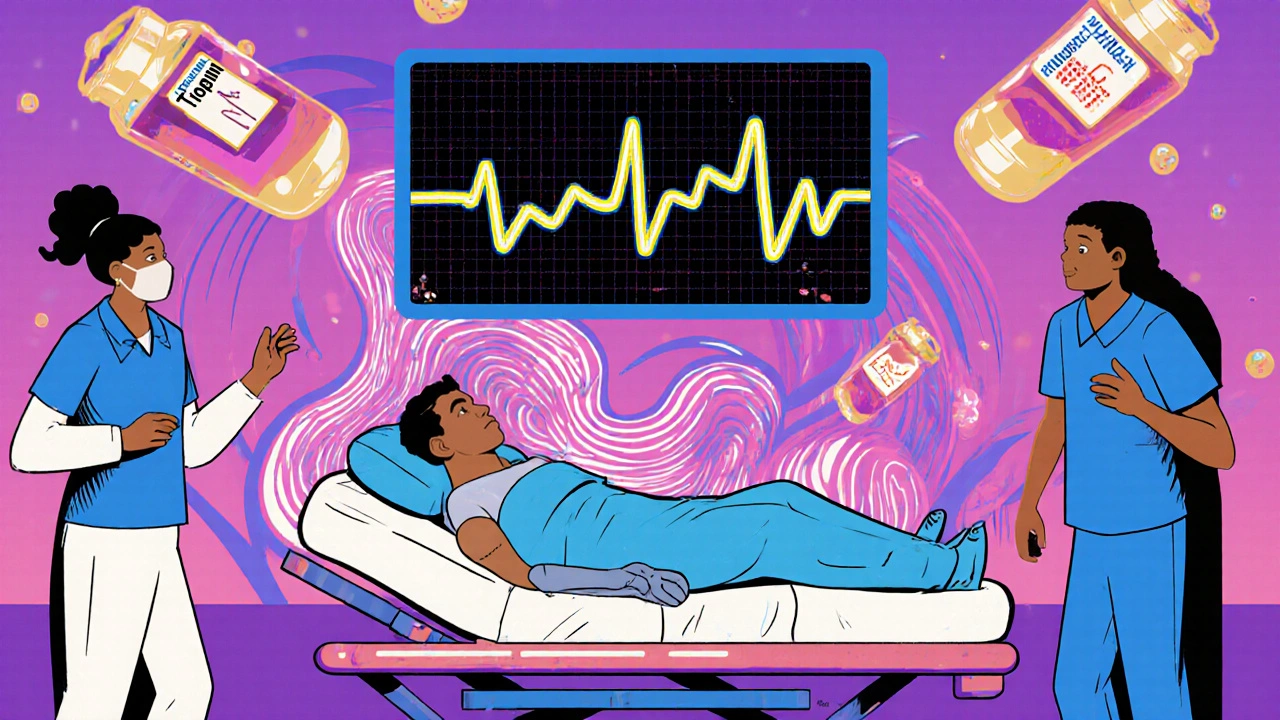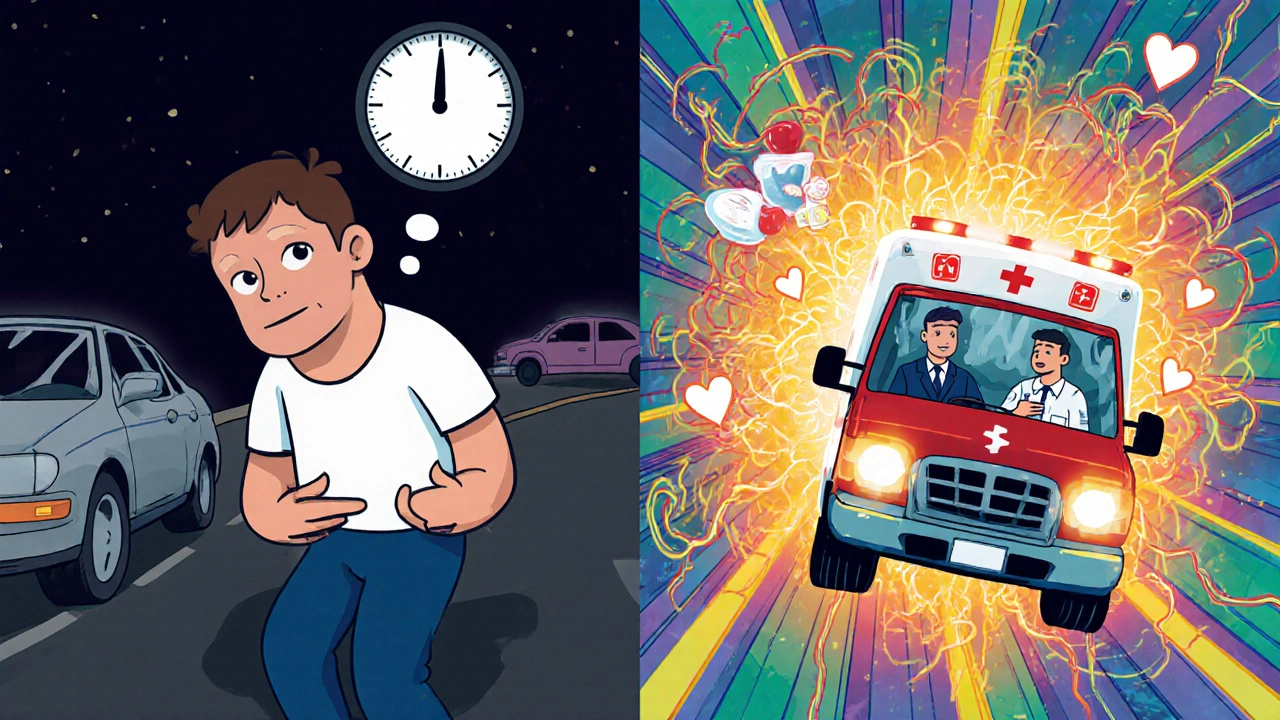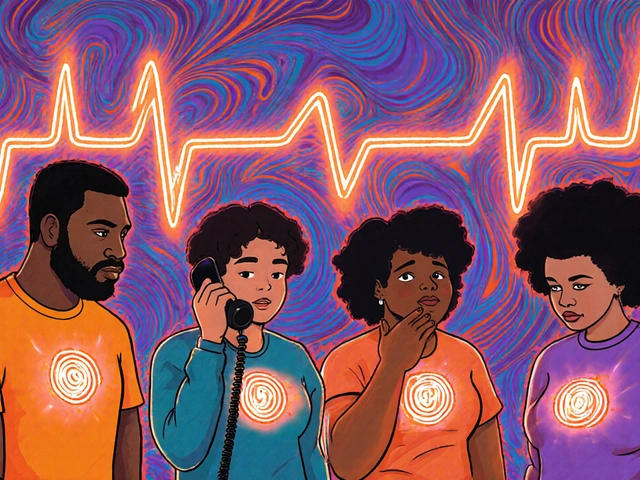
When your chest hurts, it’s natural to panic. Is it heartburn? A pulled muscle? Or something serious like a heart attack? The truth is, chest pain isn’t always what it seems - but it’s also not something to ignore. Every year in the U.S., millions of people show up at emergency departments with chest discomfort. Only about 1 in 10 of them are having a heart attack. But that 10%? That’s the group that can’t afford to wait. Knowing when to call 9-1-1 instead of driving yourself to the hospital could save your life.
What Counts as Chest Pain?
Chest pain isn’t just a sharp stab or squeezing feeling in the middle of your chest. It can show up as pressure, tightness, burning, or even just a strange heaviness. And it doesn’t even have to be in your chest at all. You might feel it in your left arm, jaw, neck, back, or upper belly. Some people describe it like an elephant sitting on their chest. Others just feel really tired, short of breath, or nauseated - especially women and older adults.
The American Heart Association defines chest pain broadly: any discomfort in the chest, shoulders, arms, neck, jaw, or upper abdomen that’s new, unusual, or doesn’t go away. If you’re unsure whether it’s serious, treat it like it is. Don’t try to tough it out. Don’t wait to see if it gets better. If you’re experiencing this for the first time - or it’s worse than usual - get help now.
When to Call 9-1-1 Immediately
Don’t drive yourself. Don’t wait for a ride. Call 9-1-1 right away if you have chest discomfort and any of these symptoms:
- Sweating (diaphoresis) - cold, clammy skin, even if it’s not hot
- Shortness of breath that doesn’t improve with rest
- Nausea, vomiting, or sudden dizziness
- Heart rate over 100 beats per minute or very low blood pressure
- Feeling faint, lightheaded, or like you’re about to pass out
These aren’t just random symptoms. They’re red flags that your heart might be under severe stress. Emergency responders are trained to start treatment the moment they arrive. They can give you aspirin, monitor your heart, and even begin life-saving interventions before you reach the hospital. Driving yourself delays care by 25-30 minutes on average. That’s time you can’t afford to lose.
The ECG Is Your First Line of Defense
When you arrive at the emergency department, the first thing they’ll do is hook you up to an electrocardiogram (ECG). This test takes less than a minute and shows how your heart is electrically firing. It’s the single most important tool in the first 10 minutes of evaluation.
According to the 2021 AHA/ACC guidelines, every hospital must get and interpret an ECG within 10 minutes of your arrival. Why? Because if you’re having a STEMI - a type of heart attack where a major artery is completely blocked - that ECG will show it right away. And if it does, the clock starts ticking. The goal is to open that artery within 90 minutes of your arrival. Every minute counts. Delayed treatment means more heart muscle dies.
Even if your first ECG looks normal, don’t assume you’re safe. Some heart attacks don’t show up on the first test. That’s why doctors often repeat the ECG every 15-30 minutes if your symptoms persist. A subtle change over time can be more telling than a single normal result.

Troponin Tests: The Blood Marker That Tells the Truth
Along with the ECG, doctors will draw blood to check for cardiac troponin - a protein released when heart muscle is damaged. Modern high-sensitivity troponin tests can detect even tiny amounts of damage. In fact, with these newer tests, doctors can rule out a heart attack in 70-80% of chest pain patients within just 1-2 hours.
But here’s the catch: these tests only work if they’re the right kind. Older troponin assays can’t pick up early damage. If your hospital is still using outdated equipment, the results may be misleading. Most U.S. hospitals switched to high-sensitivity troponin by the end of 2022, so this isn’t usually an issue anymore - but it’s something to be aware of if you’re in a rural or under-resourced area.
Doctors don’t rely on troponin alone. They combine it with your symptoms, ECG, age, risk factors, and other signs to make a full picture. That’s where tools like the HEART score come in. It’s a simple checklist: History (what you’re describing), ECG findings, Age, Risk factors (like smoking or diabetes), and Troponin level. A score of 0-3? You’re likely low risk and may go home. A score of 7-10? You’re in the high-risk zone and need immediate action.
What About Chest Pain That’s Not a Heart Attack?
Not every chest pain is cardiac. In fact, most aren’t. Other common causes include:
- Acid reflux or GERD - burning that gets worse after eating or lying down
- Muscle strain or costochondritis - pain that worsens with movement or pressing on the chest
- Lung issues like pneumonia or pulmonary embolism - sharp, stabbing pain with breathing
- Anxiety or panic attacks - often accompanied by hyperventilation and tingling in hands or feet
But here’s the problem: some of these conditions - like pulmonary embolism - are just as dangerous as a heart attack. That’s why doctors don’t just assume it’s “just heartburn.” They rule out the deadly stuff first. If your ECG and troponin are normal but you’re still in pain, they might order a CT scan to check for a blood clot in your lungs or an echocardiogram to look at your heart’s function.
There’s also a growing group of patients called INOCA - those with ischemia (reduced blood flow) but no blocked arteries. This is more common than people think, affecting 5-10% of chest pain cases. It’s often missed by standard tests and requires specialized evaluation. If you’ve had multiple negative tests but still get chest pain with exertion, talk to a cardiologist about this possibility.
Why Not Just Go to Urgent Care?
It’s tempting to skip the ER and head to urgent care. But if your chest pain could be cardiac, urgent care isn’t equipped to handle it. They don’t have the 24/7 cardiac monitoring, the rapid lab turnaround, or the immediate access to cath labs that emergency departments do. If you’re having a heart attack and go to urgent care, you’ll likely be transferred to the ER anyway - and by then, time has passed.
The 2021 AHA/ACC guideline is clear: patients with unstable vital signs, ongoing pain, or abnormal ECG findings must be evaluated in an emergency department. No exceptions. If you’re unsure, err on the side of caution. It’s better to be evaluated and told you’re fine than to wait and risk a preventable tragedy.

What Happens After the Emergency?
If you’re cleared and sent home, you’re not done. Even low-risk patients need follow-up. Your doctor will likely schedule a stress test, echocardiogram, or coronary CT angiography to check for underlying heart disease. Don’t ignore these appointments. Many people who survive a heart attack didn’t realize they had coronary artery disease until it was too late.
And if you’ve been diagnosed with INOCA or microvascular disease, your treatment plan will be different. You might need medications like nitrates, beta-blockers, or calcium channel blockers - not just lifestyle changes. These conditions are real, underdiagnosed, and can significantly impact your quality of life.
What You Can Do Now
You don’t have to wait for chest pain to act. Here’s how to prepare:
- Know your risk factors: high blood pressure, diabetes, smoking, obesity, family history of early heart disease
- Keep a list of your medications and allergies handy - keep it on your phone or in your wallet
- Teach your family what signs to look for - especially if you live alone
- Make sure your phone is charged and you know how to call 9-1-1 quickly
- Don’t keep aspirin in the bathroom cabinet - keep it by your bed or in your car
And if you ever feel uncertain - call 9-1-1. Emergency medical services exist for exactly this reason. They’re not there to judge you. They’re there to make sure you’re okay. Even if it turns out to be indigestion, you’ll walk away knowing you did the right thing.
Can chest pain be caused by stress or anxiety?
Yes, anxiety and panic attacks can cause chest tightness, rapid heartbeat, and shortness of breath that feel very similar to a heart attack. But you can’t tell the difference on your own. Even if you think it’s anxiety, it’s still safer to get checked out in the emergency department. Doctors can quickly rule out heart problems with an ECG and troponin test. Once cardiac causes are excluded, anxiety can be addressed appropriately.
If my ECG is normal, does that mean I’m safe?
Not necessarily. About half of all heart attacks don’t show up on the first ECG. That’s why doctors repeat the test every 15-30 minutes if symptoms continue. They also check troponin levels over time. A normal ECG is reassuring, but it’s not the final word. If your symptoms persist or worsen, further testing like a stress test or CT scan may be needed.
Is it safe to drive myself to the hospital if I have chest pain?
No. Driving yourself increases the risk of sudden cardiac arrest on the road, which can be fatal. Emergency medical services (EMS) can start treatment immediately - giving you oxygen, aspirin, and monitoring your heart while en route. They can also alert the hospital ahead of time so the team is ready. Studies show EMS transport reduces delays in treatment by 25-30% compared to personal vehicle transport.
Can young people have heart attacks?
Absolutely. While heart attacks are more common in older adults, they’re rising in younger people - especially those with obesity, diabetes, smoking, or a family history. About 1 in 5 heart attacks now happen in people under 55. Don’t assume you’re too young. Symptoms like sudden fatigue, nausea, jaw pain, or unexplained shortness of breath should never be ignored, no matter your age.
What’s the difference between a heart attack and cardiac arrest?
A heart attack is a circulation problem - a blocked artery starves part of the heart of oxygen. Cardiac arrest is an electrical problem - the heart suddenly stops beating. A heart attack can lead to cardiac arrest, but they’re not the same. During a heart attack, you’re usually conscious and may have chest pain. In cardiac arrest, you collapse, stop breathing, and lose consciousness instantly. Immediate CPR and defibrillation are critical for survival in cardiac arrest.
Do women experience chest pain differently than men?
Yes. While men often report classic crushing chest pain, women are more likely to have symptoms like extreme fatigue, nausea, vomiting, back or jaw pain, and shortness of breath without obvious chest discomfort. These are called “atypical” symptoms, but they’re just as dangerous. Many women delay seeking help because they don’t recognize these as heart-related. If you’re a woman and feel unwell with new, unexplained symptoms, don’t wait - get evaluated.
Final Thought: Better Safe Than Sorry
Every second matters when your heart is in trouble. The tools we have today - fast ECGs, high-sensitivity troponin tests, AI-assisted interpretation - make it easier than ever to rule out life-threatening causes quickly. But none of that matters if you don’t act. Don’t second-guess yourself. Don’t worry about “bothering” anyone. Emergency departments are built for this. They see thousands of chest pain cases every day. They’re not going to think you’re overreacting. They’ll be glad you came.
If you’re ever in doubt - call 9-1-1. It’s the single best decision you can make when your chest hurts.


OMG I had chest pain last week and I thought I was dying 😭 turned out it was just my bra strap digging in... I still called 911 because I didn't want to be that person who dies in their driveway. EMS showed up with sirens and everything. They gave me aspirin and asked if I had a will. I said no. They said 'good, because you're gonna need one after this.' I'm alive. And slightly embarrassed. 🤷♀️
Look, I get that people panic. But let’s be real - the system is designed to overdiagnose because liability is cheaper than death. I’ve seen ERs turn a panic attack into a full cardiac workup because the doctor didn’t want to miss one in a thousand. And honestly? That’s not bad. It’s the only way we’ve reduced cardiac mortality by 40% in 20 years. The ECG, the troponin, the HEART score - these aren’t just tests, they’re cultural safeguards. We’ve trained an entire generation to treat chest pain like a bomb threat. And honestly? I’d rather live in a world where 99% of people are over-treated than one where 1% die because someone thought ‘it’s probably just gas.’
They don’t want you to know this, but the real reason they push ECGs and troponin tests is because Big Pharma owns the hospitals. Did you know that high-sensitivity troponin tests cost $187 each? And they do them three times? That’s $561 per patient. Multiply that by 2 million chest pain visits a year? That’s over $1 BILLION in lab revenue. Meanwhile, your doctor gets paid $200 for the visit. Who’s really making money here? And why do they never mention that 70% of ‘heart attacks’ are actually just inflammation from eating too much pizza? 🍕👁️🗨️
If you're unsure, call 911. No excuses. Period. 🚨
America’s medical system is the best in the world - and that’s why you gotta be ready. When I was in Iraq, our medics had a 12-second rule: if you’re bleeding out, they treat you before you even finish screaming. Here? They’ve got ECGs, troponins, cath labs, and AI algorithms running in the background. You don’t get that in some third-world country where they use a stethoscope from 1987. So yeah, call 911. You’re not being dramatic - you’re exercising your American right to not die needlessly.
Bro, in India we just drink ginger tea and pray. 😅 But seriously - I had chest pain last year and went to a small clinic. They didn’t even have a troponin test. Just asked if I was stressed. I said yes. They said ‘then take a vacation.’ I did. I went to Goa. I’m fine now. But honestly? If I were in the US, I’d be terrified to even breathe without a cardiologist watching. We need better access everywhere. Not just in fancy hospitals.
Okay but what if you’re just really anxious and your heart is fine? Like, I once Googled ‘chest pain’ and ended up convinced I had a pulmonary embolism. I drove to the ER at 2 a.m. They gave me a snack and told me to breathe. I cried. They didn’t charge me. I’m still mad I didn’t get a free MRI. But also... I’m alive? So maybe it was worth it? 🤷♀️
I used to think chest pain was for old people. Then my 28-year-old cousin had a heart attack from vaping and eating nothing but burritos. Now I carry aspirin in my pocket. Not because I’m scared - because I’m smart. If you’re reading this and you’re under 30? You’re not invincible. You’re just untested. Don’t wait for the elephant to sit on you. Call 911 before the elephant even shows up.
People in India don’t have access to troponin tests. We don’t even have enough ECG machines. But guess what? We still know when something’s wrong. You feel it. Your body doesn’t lie. If your chest is screaming, you don’t need a lab report to tell you to run. You just run. Call 911. Call your neighbor. Call your mom. Just don’t sit there and wait for it to get better. Pain is your body’s last warning before it quits. Listen to it.